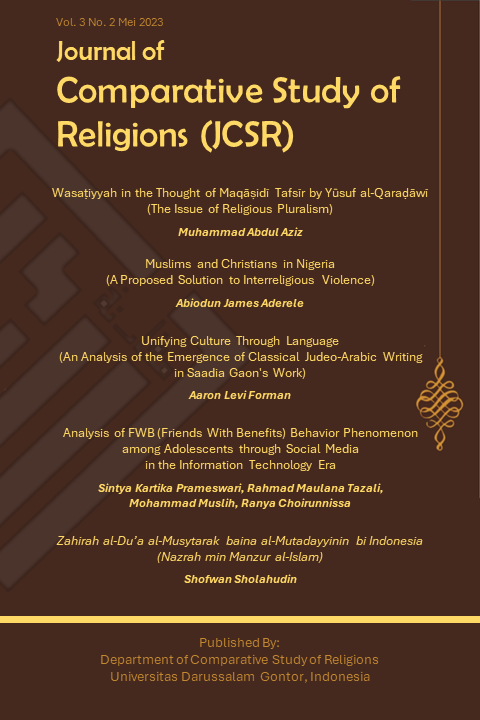Unifying Culture Through Language: An Analysis of the Emergence of Classical Judeo-Arabic Writing
DOI:
https://doi.org/10.21111/jcsr.v3i02.8766Abstract
Saadia Gaon’s (882-942) Tafsir is considered to be a turning point in the history of not only Judeo-Arabic written production, but also medieval Judeo-Arabic culture. Through his translation of the bible into Arabic written in Hebrew characters, Saadia made this text and other works of philosophy, biblical interpretation, synagogue liturgy, and linguistics accessible to a wider audience and standardized a mode of communication among Jews throughout the medieval Islamic world. This paper compares twelfth-century Cairo Geniza fragments of Saadia’s Tafsir and Siddur, analyzing the visual interplay of Hebrew and Judeo-Arabic in these sources. Changes in color, hand, damage, marginal notes, and presence or absence of writing on the verso side of the fragment shed light on the application of Saadia’s work by Jews in the medieval Mediterranean. I ultimately conclude that while production of anti-Karaite polemic may have partially motivated Saadia to write in Judeo-Arabic, the desire to standardize a uniformly understood language rooted in Classical Arabic orthography more comprehensively explains the revolutionary effect of Saadia’s work and its immediate tenth-century adaptations outside the Rabbanite Jewish community.References
Primary Sources
Ben Yeroham, Salmon. Sefer Milhamot Hashem ed. Yoseph El-Gamil. Ramlah: Institute Tifeeret Yoseph, 2000. Hebrew.
Cambridge University Library Taylor-Schechter Arabic Series 71.68.
Cambridge University Library Taylor-Schechter Arabic 18(2).17.
Cambridge University Library Taylor-Schechter Collection, Arabic 18(2).2.
Maimonides. “Iggeret Teiman†in Iggerot HaRambam ed. Yitzhak Shilat. Jerusalem: Yeshivat Brachat Moshe, 1987.
New York: Jewish Theological Seminary of America ENA NS 69.12
Secondary Sources
Ashur, Amir, and Tamar Zewi. “A Geniza Fragment of Saadya Gaon’s Bible Translation Copied by Mevorakh b. Nathan in the Twelfth Century,†Astarté 2 (2019), 113-120.
Baker, Colin, and Meira Polliack. Arabic and Judeo-Arabic Manuscripts in the Cambridge Geniza Collections: Arabic Old Series (T-S Ar. 1a-54). Cambridge: Cambridge University Press, 2001.
Blau, Joshua. “Was R. Saadia Gaon’s Arabic Translation of the Pentateuch Meant for Muslims Too?†in Modern Jewish Scholarship in Hungary: The Science of Judaism between East and West, ed. Tamás Turan and Carsten Wilke. Berlin: De Gruyter, 2016 (70-72).
Blau, Joshua. The Emergence and Linguistic Background of Judeo-Arabic: A Study of the Origins of Middle Arabic. Jerusalem: Ben-Zvi Institute, 1965.
Blau, Joshua. “Medieval Judeo-Arabic†in Jewish Languages: Theme and Variations: Proceedings of Regional Conferences of the Association for Jewish Studies Held at the University of Michigan and New York University in March-April 1975 ed. Herbert Paper. Cambridge: Association for Jewish Studies, 1978 (121-131).
Blau, Joshua and Simon Hopkins. “On Early Judeo-Arabic Orthography,†Zeitschrift für Arabische Linguistik 12 (1984).
Brody, Robert. Sa’adyah Gaon. Liverpool: Liverpool University Press, 2013.
Brody, Robert. “Sifrut ha-Geonim ve-ha-Tekst ha-Talmudi†[The Literature of the Geonim and the Talmudic Text], Mehqerei Talmud [Talmudic Studies], vol. 1, ed. Yaakov Sussman and David Rosenthal. Jerusalem: Magnes Press, 1990.
Goitein, Shlomo Dov. Jews and Arabs: Their Contacts Through the Ages. New York: Schocken Books, 1955.
Goitein, Shlomo Dov. “The Documents of the Cairo Geniza as a Source for Mediterranean Social History,†Journal of the American Oriental Society 80:2 (1960), 91-100.
Kendrick, Laura. Animating the Letter: The Figurative Embodiment of Writing from Late Antiquity to the Renaissance. Columbus: Ohio State University Press, 1999.
Hary, Benjamin. Multiglossia in Judeo-Arabic. Leiden: Brill, 1992.
Isaac Kalimi, Fighting Over the Bible: Jewish Interpretation, Sectarianism and Polemic from Temple to Talmud and Beyond. Leiden: Brill, 2017.
Nemoy, Leon. “The Milhamoth Hashem of Salmon ben Yeroham,†The Jewish Quarterly Review 28:1 (1937), 91-94.
Perlmann, Moshe. “The Medieval Polemics Between Judaism and Islam†in Religion in a Religious Age ed. S.D. Goitein. Cambridge: Association for Jewish Studies (1974), 103-138.
Perry, Micha. “A Cultural History of Bilingual Charters from Catalonia: Language and Identity,†Jewish Quarterly Review 111:2 (2021), 185-210.
Polliack, Meira. The Karaite Tradition of Arabic Bible Translation: A Linguistic and Exegetical Study of Karaite Translations of the Pentateuch from the Tenth and Eleventh Centuries C.E.. Leiden: Brill, 1997.
Rustow, Marina. “Karaites, Real and Imagined: Three Cases of Jewish Heresy,†Past and Present 197:1 (2007), 35-74.
Rustow, Marina. “Jews and the Islamic World: Transitions from Rabbinic to Medieval Contexts,†in The Bloomsbury Companion to Jewish Studies ed. Dean Philip Bell. New York: Bloomsbury Publishing, 2013.
Scheindlin, Raymond. “Merchants and Intellectuals, Rabbis and Poets'' in Cultures of the Jews: A New History ed. David Biale. New York: Schocken Books, 2002 (313-386).
Septimus, Bernard. Hispano-Jewish Culture in Transition: The Career and Controversies of Ramah. Cambridge: Harvard University Press, 1982.
Shohat, Ella. “The Invention of Judeo-Arabic: Nation, Partition and the Linguistic Imaginary.†Interventions 19:2 (2017), 153-200.
Skoss, Solomon. Saadia Gaon, the Earliest Hebrew Grammarian. Philadelphia: Dropsie College Press, 1955.
Stern, Sacha. The Jewish Calendar Controversy of 921/922 CE. Leiden: Brill, 2019.
Tobi, Joseph. “Written Judeo-Arabic: Colloquial versus Middle Arabic†in Middle Arabic and Mixed Arabic, ed. Liesbeth Zack and Arie Schippers. Leiden: Brill, 2012 (265-278).
Zewi, Tamar. The Samaritan Version of Saadya Gaon’s Translation of the Pentateuch. Leiden: Brill, 2015
Downloads
Published
How to Cite
Issue
Section
License
Copyright (c) 2023 Journal of Comparative Study of Religions (JCSR)

This work is licensed under a Creative Commons Attribution-NonCommercial-ShareAlike 4.0 International License.
The author whose published manuscript approved the following provisions:Â
The right of publication of all material published in the journal / published in the JCSR is held by the editorial board with the knowledge of the author (moral rights remain the author of the script).
The formal legal provisions for access to digital articles of this electronic journal are subject to the terms of the Creative Commons Attribution-NonCommercial-ShareAlike 4.0 International License (CC BY-NC-SA 4.0), which means that JCSR reserves the right to save, transmit media or format, Database), maintain, and publish articles without requesting permission from the Author as long as it keeps the Author's name as the owner of Copyright.
Printed and electronic published manuscripts are open access for educational, research and library purposes. In addition to these objectives, the editorial board shall not be liable for violations of copyright law.




2.png)
